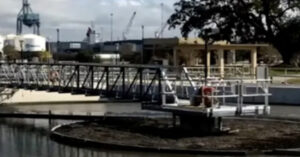This website uses cookies so that we can provide you with the best user experience possible. Cookie information is stored in your browser and performs functions such as recognising you when you return to our website and helping our team to understand which sections of the website you find most interesting and useful.
Knight Materials
Structured Media Replaces Monolithic Blocks to Solve RTO Clogs for Wastewater Treatment Plant
Background
Buckman Water Reclamation Facility (WRF) is JEA’s largest wastewater treatment facility, with a permitted annual average daily flow treatment capacity of approximately 52.5 million gallons per day. Buckman Regional Residuals Biosolids Treatment Facility in Jacksonville, Florida, is owned by JEA (formerly Jacksonville Electric Authority).
As a publicly owned utility, JEA serves hundreds of thousands of residents in the area. The Buckman Water Reclamation Facility treats more than 22 million gallons per day (MGD) in its activated sludge process. A biosolids facility processes solids from this and four other JEA facilities in three anaerobic digesters to produce fertilizer.
In the initial phase, the digested biosolids must have moisture removed in a dryer. A regenerative thermal oxidizer (RTO) processes waste gas from the dryers used at the wastewater treatment (WWT) facility.
Situation
Buckman technicians found that the monolithic ceramic block media within the RTO frequently clogged with silica powder, a byproduct of siloxane found in wastewater.
Organic particulates aren’t a clogging issue because they can be disposed of using the bake-out feature in an RTO. This process carbonizes the organic particulates at elevated temperatures, causing them to detach from the ceramic media and subsequently carried out with the stack exhaust gas.
Challenge: Previous Tower Saw Decades of Service
The global siloxane market, driven mainly by its increased use in personal care products, has exhibited an upward trajectory during the past several years, with a forecasted CAGR (Compound Annual Growth Rate) of 5.5% through 2028. The siloxanes from skincare and haircare products pass into the wastewater treated at the biosolids facility.
There, the RTO handles the waste gas coming from the dryer to burn off air pollutants and odors—and as such, treats waste gas laden with silica oxides, clogging the channels of the monolithic blocks within the RTO. This reduces the system’s efficiency, burns more energy to compensate for the blocked ceramic media, and requires excessive downtime to remove the silica clogging the channels in the blocks.
The operators at Buckman turned to Knight Materials Technology for a solution due to its reputation for specializing in environmental heat transfer equipment, mainly for handling corrosive or inorganic materials.
End Result: Years of Trouble-Free Service
Whether planning a retrofit, upgrade, or new construction project, FLEXERAMIC structured packing from Knight Material Technologies is the only packing media that demands minimal maintenance, enhances energy efficiencies, and delivers reliable performance for decades.
The superior performance of FLEXERAMIC structured packing provides enhanced controlled odor or emissions of volatile organic compounds (VOCs) to improve air quality and comply with local or federal environmental regulations.
Looking for your own “set it and forget it” RTO construction or retrofit? Call Knight Material Technologies for your next tower design.
For this tower, the company utilized:




